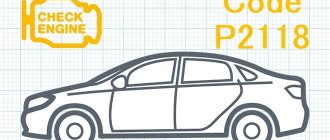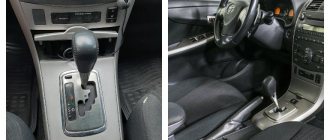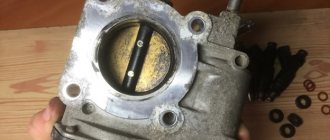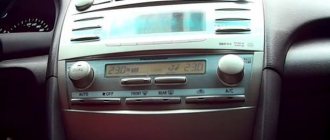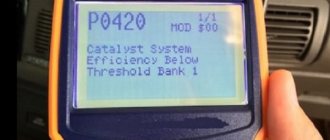What are the symptoms of a P0120 code?
- When this error appears, the Check Engine light will light up on the vehicle's dashboard. The ECM will put the engine into limp mode and stop current flowing to the throttle actuator. In this case, the opening angle of the throttle valve will be no more than 6 degrees.
- Problems may arise with the control of fuel injection and ignition timing.
- Engine power may be reduced due to slow throttle response to changes in the accelerator pedal position.
- The engine may idle at higher speeds, but the vehicle will not accelerate as expected.
Note : Symptoms of this error may vary depending on the make and model of your vehicle.
On which cars is this problem most common?
The problem with code P0120 can occur on different machines, but there are always statistics on which brands this error occurs more often. Here is a list of some of them:
- Audi
- BMW (BMW E46)
- Chery (Chery Tiggo)
- Chevrolet (Chevrolet Tahoe)
- Citroen
- Daewoo (Daewoo Matiz)
- Fiat
- Ford (Ford Mondeo, Focus)
- Hover
- Hummer H2
- Hyundai (Hyundai Porter, Santa Fe, Terracan)
- Infiniti (Infiniti qx4)
- Kia
- Lexus (Lexus rx300, sc430)
- Mazda
- Mercedes (Mercedes w203, w211)
- Mitsubishi (Mitsubishi Galant, Karizma, Lancer, Montero, Pajero, Tsediya)
- Nissan (Nissan Almera, Vanette, Vingroad, Qashqai, Cube, March, Primera, Sunny, X-Trail)
- Opel (Opel Astra, Vectra, Vivaro, Zafira, Corsa, Omega)
- Peugeot (Peugeot 206, 307, 406)
- Renault (Renault Duster, Laguna, Logan, Master, Megan, Sandero, Simbol, Scenic)
- Ssangyong (Sangyong Kyron)
- Suzuki
- Toyota (Toyota Camry, Corolla, Land Cruiser, Mark 2, Solara, Tacoma)
- Volkswagen
- VAZ
With fault code P0120, you can sometimes encounter other errors. The most common ones are: P0110, P0115, P0121, P0122, P0123, P0124, P0220, P0300, P0340, P0420, P1122, P1410, P1516, P1550, P1705, P2135, B0136, B1421, B1431.
How does a mechanic diagnose a P0120 code?
When diagnosing this error, the mechanic will do the following:
- Reads all stored data and error codes using an OBD-II scanner to find out when and under what circumstances the P0120 error occurred
- Clear error codes from the computer's memory and test drive the vehicle to see if P0120 appears again
- Visually inspect the electrical wires and connectors related to the throttle position sensor “A” for looseness or damage.
- Compare the readings of throttle position sensors “A” and “B” using a scanner and, if necessary, replace the faulty sensor
Reasons for the error
A P0120 code may mean that one or more of the following problems have occurred:
- Open throttle position sensor circuit or poor electrical connection.
- The throttle position sensor wiring harness is open or shorted to ground or another wire.
- Corroded MAP or TPS connector.
- The throttle position sensor is faulty.
- Throttle return spring stuck.
- The engine control module (PCM) is faulty.
Common mistakes when diagnosing code P0120
- Failure to visually inspect the throttle position sensor “A”, as well as the associated electrical wires and connector
- Neglecting to check for an error code using a scanner, clearing the code from the computer's memory, and rechecking the system before performing any repair work
- Hasty replacement of throttle position sensor “A”
- Neglecting to check the readings and performance characteristics of the throttle position sensors “A” and “B” before starting repair work and after its completion
Throttle sensor operation
The sensor records the angle of the throttle valve, this is its main task. It works on a non-contact principle based on the Hall effect. The device can be found directly on the throttle body.
This design solution played a decisive role in the reliability of the device and the accuracy of the measurements it transmitted.
The throttle valve sensor (TDS) also has another designation TP or TPS according to the English abbreviation. It can be with mechanical and electrical drives.
The operation of the remote sensing sensor is ensured by two complementary circuits - VTA1 and VTA2.
The voltage of the signal coming from the first circuit, depending on the throttle valve position angle, changes, thereby the ECU understands what position the throttle valve is in at a certain point in time.
The VTA2 circuit is the monitoring circuit and ensures that there are no failures in the first circuit.
The range of voltage readings supplied from the sensor to the ECU, depending on the car model, may differ, but, as a rule, it is from 0 V (or 0.45) when the throttle is closed and up to 5 Volts when the throttle is fully open.
The ECU uses the received information to:
- Creating the correct air-fuel mixture at certain engine operating modes.
- Speed adjustments.
- Increased fuel supply.
Details in the video.
Additional comments for troubleshooting P0120
- Along with the P0120 code, there may also be other error codes related to the throttle position sensor that need to be investigated and resolved.
- The most common cause of P0120 is a faulty throttle position sensor that is not properly detecting the throttle angle.
- As a rule, when errors related to the throttle position sensor appear, emergency mode is activated, and the symptoms of such errors are almost the same.
Test methods and solutions
The method for correcting the breakdown must be chosen based on an analysis of the reasons that led to it. In particular, you need to check the nodes listed below.
Throttle sensor . As stated above, the sensor is part of the damper, so it cannot be removed. Therefore, in most cases it makes sense to remove the entire assembly and make an inspection. However, it is necessary to perform such work only if you clearly understand the algorithm of the procedure. Otherwise, it is better to seek help from a car service or service station. Some car owners also advise checking the car's crankcase ventilation system. If the sensor is faulty, then it is unlikely to be repaired. The worst case scenario is that you need to buy a new throttle body assembly and replace it. To reduce cash costs, it makes sense to buy a used unit (for example, at a car market or services that dismantle old cars).
The exception is commercially available throttle position sensors designed for manually controlled throttle bodies. That is, using a cable from the gas pedal. In this case, you can buy a new sensor and replace it.
Throttle valve assembly . It is noted that often the cause of error P0120 in the ECU is a dirty damper. It is also possible that some foreign object (garbage) got into her work area. In this case, it is necessary to inspect the throttle valve and clean it. The procedure is simple and even a novice car owner can easily cope with it. For cleaning, it makes sense to use special cleaning compounds, for example, carburetor cleaners.
If cleaning the damper does not help, then additional diagnostics must be done. In particular, check the condition of the damper motor and the condition of the return spring. Unfortunately, repairing the damper is not always possible, and on many cars this unit is considered completely beyond repair (for example, on some Renault models). Therefore, in order to be sure to get rid of the P0120 error, you often have to buy and install a new throttle valve.
When performing repair work, some car owners also advise dismantling the manifold, cleaning it, inspecting the gaskets (rings, replacing them if necessary), and lubricating them with sealant.
Electronic engine control unit . In rare cases, complex electronics fail due to hardware or software errors. This is relevant, in particular, for models in which the ECU is located in close proximity to the cylinder block (for example, for some Opel models). As a result, the electronic unit heats up and may produce incorrect signals. This applies not only to error P0120, but also to many others.
Therefore, if the ECU “goes wrong”, it will produce not one, but several errors. If such a breakdown is suspected, independent diagnosis and repair are impossible. The mentioned procedures must be performed in service centers using special additional equipment.
For reference, we provide data on the voltage value of the output signal in the VTA1 circuit of the throttle position sensor. The data is relevant for the Toyota RAV4, but for other cars the values will be identical or differ slightly. So:
- accelerator pedal fully released - 0.5...1.1 V;
- accelerator pedal fully depressed - 3.3...4.9 V.
Electrical circuits of the sensor . The simplest and most effective diagnostic method is to use software to read problems with the ECU. There are many such programs; accordingly, their interfaces are also different, so it makes no sense to describe their work. With their help, it is necessary to find out the voltage on the VTA1 and VTA2 circuits in various situations (including emergency mode and at different engine speeds).
Let's give an example for the already mentioned Toyota RAV4, the sensor connection diagram for which you can see in the figure. So, the following situations are possible:
| Throttle position (VTA1), with the accelerator pedal released | Throttle position No. 2 (VTA2), with the accelerator pedal released | Throttle position (VTA1), accelerator pedal pressed | Throttle position No. 2 (VTA2), accelerator pedal pressed | Faulty area |
| 0-0.2 V | 0-0.2 V | 0-0.2 V | 0-0.2 V | Open circuit VC |
| 4.5-5.0 V | 4.5-5.0 V | 4.5-5.0 V | 4.5-5.0 V | Open circuit E2 |
| 0-0.2 V, or 4.5-5.0 V | 2.4-3.4 V (in emergency mode) | 0-0.2 V, or 4.5-5.0 V | 2.4-3.4 V (in emergency mode) | Open or short circuit to ground in the VTA1 circuit |
| 0.7-1.3 V (in emergency mode) | 0-0.2 V, or 4.5-5.0 V | 0.7-1.3 V (in emergency mode) | 0-0.2 V, or 4.5-5.0 V | Open or short circuit to ground in the VTA2 circuit |
| 0.5-1.1 V | 2.1-3.1 V | 3.3-4.9 V (not in emergency mode) | 4.6-5.0 V (not in emergency mode) | TP sensor circuit is working normally |
Remember that after directly eliminating the breakdown, you must delete the error information from the memory of the electronic engine control unit. In some cases, information disappears on its own, but if this does not happen automatically, then you need to do it forcibly. There are two options.
The first is to use the software that generated the error information. The programs have a function to clear the ECU memory. The second option is simpler, and it involves disconnecting the negative terminal of the battery for 10...15 seconds. This operation will turn off the ECU, and after turning it on again, it will reboot and will contain fresh information about the state of the vehicle components. It is preferable, of course, to use the first option, but if you do not have a scanner with software, then you can also use the second option.
Diagnosing the malfunction that caused the P0120 error to appear is not difficult if you have an error reading scanner. As practice shows, to eliminate a malfunction it is often enough to simply inspect and clean the throttle valve assembly. And only in rare cases does it become necessary to replace the entire throttle along with the throttle position sensor.
Conclusion
Throttle valve error code P0120 is not critical , and if it occurs, the car can be used. However, with it, the electronic engine control unit puts the engine into emergency mode, in which there is no possibility of dynamic acceleration and full power gain. Therefore, driving a car in such conditions is difficult.
Therefore, at the slightest opportunity, it makes sense to inspect the throttle valve assembly and, if necessary, carry out repair work to eliminate the error. And do not forget to delete the error from the ECU memory after this.
Existing error options
There are four types of error p0120.
When diagnosing, the scanning program designates them as follows:
- 2009 (001) M16/6 (“Throttle valve actuator” or “Throttle valve actuator”) Actual value potentiometer or “Actual potentiometer value”, Adaptation [p0120] (adaptation error).
- 2009 (004) M16/6 (“Throttle valve actuator” or “Throttle valve actuator”) Actual value potentiometer or “Actual potentiometer value”, Adaptation Emergency running [p0120] (adaptation start error).
- 2009 (008) M16/6 (“Throttle valve actuator”) Actual value potentiometer, N3/10 (ME-SFI [ME] control unit) [p0120] (throttle valve actuator) flaps).
- 2009 (002) M16/6 (“Throttle valve actuator”) Actual value potentiometer, Return spring [p0120] (return spring error).

